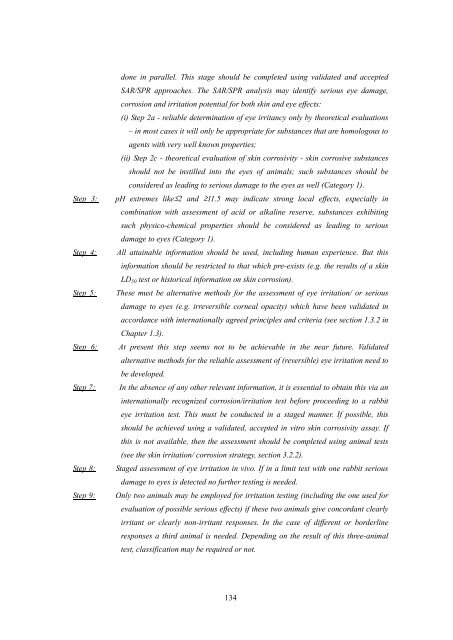GHS Classification Guidance for the Japanese Government
GHS Classification Guidance for the Japanese Government
GHS Classification Guidance for the Japanese Government
Create successful ePaper yourself
Turn your PDF publications into a flip-book with our unique Google optimized e-Paper software.
done in parallel. This stage should be completed using validated and accepted<br />
SAR/SPR approaches. The SAR/SPR analysis may identify serious eye damage,<br />
corrosion and irritation potential <strong>for</strong> both skin and eye effects:<br />
(i) Step 2a - reliable determination of eye irritancy only by <strong>the</strong>oretical evaluations<br />
– in most cases it will only be appropriate <strong>for</strong> substances that are homologous to<br />
agents with very well known properties;<br />
(ii) Step 2c - <strong>the</strong>oretical evaluation of skin corrosivity - skin corrosive substances<br />
should not be instilled into <strong>the</strong> eyes of animals; such substances should be<br />
considered as leading to serious damage to <strong>the</strong> eyes as well (Category 1).<br />
Step 3: pH extremes like≤2 and ≥11.5 may indicate strong local effects, especially in<br />
combination with assessment of acid or alkaline reserve, substances exhibiting<br />
such physico-chemical properties should be considered as leading to serious<br />
damage to eyes (Category 1).<br />
Step 4: All attainable in<strong>for</strong>mation should be used, including human experience. But this<br />
in<strong>for</strong>mation should be restricted to that which pre-exists (e.g. <strong>the</strong> results of a skin<br />
LD50 test or historical in<strong>for</strong>mation on skin corrosion).<br />
Step 5: These must be alternative methods <strong>for</strong> <strong>the</strong> assessment of eye irritation/ or serious<br />
damage to eyes (e.g. irreversible corneal opacity) which have been validated in<br />
accordance with internationally agreed principles and criteria (see section 1.3.2 in<br />
Chapter 1.3).<br />
Step 6: At present this step seems not to be achievable in <strong>the</strong> near future. Validated<br />
alternative methods <strong>for</strong> <strong>the</strong> reliable assessment of (reversible) eye irritation need to<br />
be developed.<br />
Step 7: In <strong>the</strong> absence of any o<strong>the</strong>r relevant in<strong>for</strong>mation, it is essential to obtain this via an<br />
internationally recognized corrosion/irritation test be<strong>for</strong>e proceeding to a rabbit<br />
eye irritation test. This must be conducted in a staged manner. If possible, this<br />
should be achieved using a validated, accepted in vitro skin corrosivity assay. If<br />
this is not available, <strong>the</strong>n <strong>the</strong> assessment should be completed using animal tests<br />
(see <strong>the</strong> skin irritation/ corrosion strategy, section 3.2.2).<br />
Step 8: Staged assessment of eye irritation in vivo. If in a limit test with one rabbit serious<br />
damage to eyes is detected no fur<strong>the</strong>r testing is needed.<br />
Step 9: Only two animals may be employed <strong>for</strong> irritation testing (including <strong>the</strong> one used <strong>for</strong><br />
evaluation of possible serious effects) if <strong>the</strong>se two animals give concordant clearly<br />
irritant or clearly non-irritant responses. In <strong>the</strong> case of different or borderline<br />
responses a third animal is needed. Depending on <strong>the</strong> result of this three-animal<br />
test, classification may be required or not.<br />
134
















